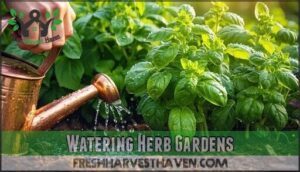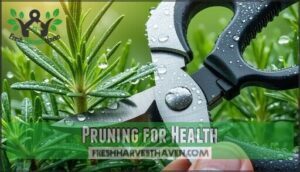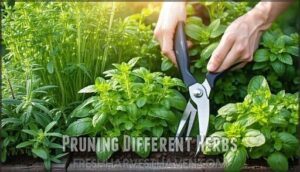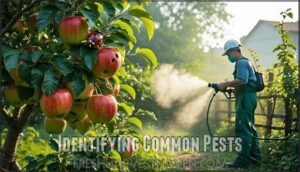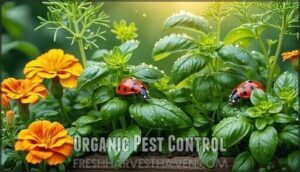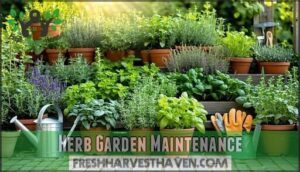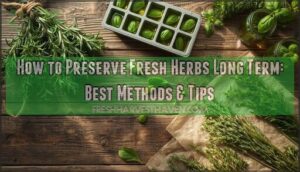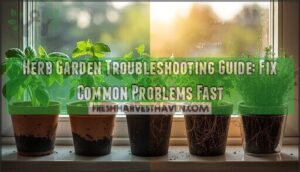This site is supported by our readers. We may earn a commission, at no cost to you, if you purchase through links.

You’ll need to monitor soil moisture daily, pinch flowers to encourage leaf growth, and adjust care routines as temperatures shift.
Most herbs prefer well-draining soil and morning watering, while Mediterranean varieties like rosemary thrive with less frequent irrigation than moisture-loving basil.
Regular harvesting actually strengthens plants and promotes bushier growth.
The key lies in understanding each herb’s unique preferences and timing your maintenance tasks correctly—something that becomes intuitive once you master the fundamental principles of herb garden maintenance, which involves mastering the fundamental principles.
Table Of Contents
- Key Takeaways
- Herb Garden Planning
- Watering Herb Gardens
- Herb Pruning Techniques
- Herb Garden Pest Control
- Herb Garden Maintenance
- Frequently Asked Questions (FAQs)
- How do you maintain an herb garden?
- When should herbs be cut back?
- What herbs should not go next to each other?
- What is the mother of all herbs?
- What herbs should not be planted together?
- When should I prune my herb garden?
- Are herb gardens easy to maintain?
- Can I grow herbs indoors year-round?
- How do companion plants benefit herbs?
- What herbs work best for beginners?
- Conclusion
Key Takeaways
- You’ll need to water consistently but avoid overdoing it—check soil moisture by inserting your finger two inches deep, and water only when it’s dry to prevent root rot.
- Regular pruning and harvesting actually strengthen your plants, so pinch flowers to encourage leaf growth and trim herbs frequently to promote bushier growth.
- You can naturally control pests by companion planting herbs like basil with tomatoes, using beneficial insects, and applying organic sprays like neem oil instead of harsh chemicals.
- Different herbs have unique needs—Mediterranean varieties like rosemary thrive with less water and full sun, while moisture-loving herbs like basil need more frequent watering and can tolerate partial shade.
Herb Garden Planning
Successful herb garden planning starts with choosing herbs that match your local growing conditions and culinary preferences.
You’ll need to take into account factors like sunlight requirements, mature plant sizes, and companion planting relationships to create a thriving garden layout.
Selecting Right Herbs
Your herb selection forms the foundation of successful herb garden maintenance.
Choose herbs that match your growing space, climate, and kitchen needs for garden success.
Choose varieties based on your culinary preferences and space constraints. Mediterranean herbs like thyme and oregano need full sunlight, while parsley tolerates partial shade.
Consider growth habits—bushy basil needs 30cm spacing, while compact chives work in containers.
Plan companion planting early to maximize garden health and pest resistance.
Designing Garden Layout
Planning your garden layout requires balancing space optimization with aesthetic appeal.
Position tall herbs like rosemary in back rows, medium herbs in middle sections, and low-growing varieties like thyme up front for accessibility design.
Consider sunlight considerations when placing sun-loving basil near shade-tolerant parsley.
Companion planting herbs like basil near tomatoes maximizes your outdoor herb garden space while creating natural pest deterrents and visual interest.
Climate and Soil Conditions
Understanding your local climate impact and soil conditions forms the foundation of successful herb garden care.
Test your soil pH annually – most herbs thrive in 6.0-7.0 range, while Mediterranean varieties prefer near-neutral levels.
Guarantee proper drainage needs through loamy soil or raised beds, preventing root rot.
Consider regional variations when selecting herbs, as hardy perennials withstand zones 3-9 while tender varieties need protection.
Optimize sunlight exposure with 6-8 hours daily for peak herb cultivation and essential oil production.
Watering Herb Gardens
Proper watering keeps your herbs thriving without drowning their delicate root systems.
You’ll master timing, recognize soil needs, and prevent the common mistake of overwatering that kills more herb gardens than drought.
Watering Frequency
Success doesn’t bloom without consistency. You’ll need to establish a watering schedule that reflects your herb type and container size.
Most herbs prefer deep, infrequent watering rather than daily sprinkling. Check soil moisture by inserting your finger two inches deep—if it’s dry, it’s time to water.
Climate impact plays a huge role in maintaining herbs, so adjust your herb garden care routine accordingly during hot summers or rainy seasons. Consider that soil composition impacts frequency of watering, which is crucial for herb garden care and overall watering schedule.
Soil Conditions and Needs
Your herb garden soil creates the foundation for thriving plants, demanding specific conditions for ideal growth.
Most herbs prefer well-draining soil with a pH between 6.0-7.0, though some Mediterranean varieties tolerate slightly alkaline conditions.
You’ll need to test your soil pH regularly and add organic matter like compost to improve nutrient balance and drainage solutions for heavy clay soils.
Preventing Overwatering
Most herbs suffer from too much love rather than neglect in the matter of watering.
Check soil moisture by inserting your finger two inches deep before watering herbs.
Proper drainage solutions and smart container choices prevent root rot better than rigid watering schedules.
Well-draining herb garden soil stays moist but never soggy.
Using well draining containers is essential for healthy root systems.
Herb Pruning Techniques
Proper pruning keeps your herbs healthy, productive, and well-shaped throughout the growing season.
You’ll learn specific techniques for different herb varieties, from pinching soft stems to making strategic cuts that encourage bushy growth.
Pruning for Shape
Strategic shaping techniques transform your herb garden into a masterpiece. You’ll create bushier growth by pinching stem tips regularly, encouraging multiple branches instead of leggy stems.
Aesthetic pruning works best on Mediterranean herbs like rosemary and thyme, which respond beautifully to formal garden shaping. For topiary herbs, trim frequently using small cuts to maintain desired shapes without shocking the plant.
To encourage branching and improve airflow, pinch stems above nodes. This technique is essential for maintaining healthy and bushier growth in your herb garden.
Pruning for Health
Regular herb pruning keeps your plants healthy by improving air circulation and preventing diseases.
Remove any yellowing, damaged, or diseased leaves immediately to stop problems from spreading. Cut dead stems back to healthy growth points, and thin overcrowded areas to boost sunlight exposure throughout the plant.
To facilitate this, consider purchasing specialized cutting tools to encourage new growth while keeping herb pests and diseases at bay.
Pruning Different Herbs
Different herbs require customized pruning approaches to maximize their potential.
Basil pruning involves pinching above leaf nodes every 2-3 weeks, boosting yields by 40%.
Mint pruning means cutting stems to 2-3 inches monthly to prevent aggressive spreading.
Rosemary pruning requires gentle spring trimming of woody stems by one-third maximum.
Investing in the right cutting tools can improve results.
Here are three herb-specific pruning strategies:
- Oregano pruning – harvest tips regularly to delay flowering and increase leaf production by 35%
- Chive pruning – cut flower stalks immediately after blooming to maintain mild onion flavor
- Remove spent blooms from all herbs to redirect energy into foliage growth
Herb Garden Pest Control
Protecting your herb garden from pests requires early identification and targeted action to keep your plants healthy and productive.
You’ll need to recognize common threats like aphids, spider mites, and caterpillars while implementing natural control methods that won’t compromise your harvest.
Identifying Common Pests
Several key herb pests can devastate your garden if you don’t catch them early.
Aphids create curled, yellowing leaves and sticky honeydew on basil and mint. Whiteflies form cloud-like swarms when disturbed, targeting oregano and thyme. Spider mites leave webbing and yellow speckles on cilantro. Caterpillars chew holes in parsley, while slugs leave slime trails and irregular damage on tender herbs.
To combat these issues, consider using natural pest sprays for effective control of key herb pests, and to prevent them from leaving sticky honeydew or slime trails on your herbs.
Companion Planting
Companion planting transforms your herb garden into a natural pest-fighting system.
You’ll pair herbs like basil with tomatoes to repel aphids, while chives protect roses from black spot.
These herb companions create beneficial insects havens and improve soil health through nutrient cycling.
Marigolds between herb rows provide pest deterrence while supporting growth.
This herb gardening strategy eliminates chemicals naturally.
Organic Pest Control
Three powerful organic methods keep herb pests at bay without chemicals.
You’ll want beneficial insects like ladybugs and lacewings patrolling your garden—they’re nature’s cleanup crew. Natural sprays using neem oil or soap solutions target troublesome pests while preserving soil health.
- Manual removal of aphids and caterpillars during morning inspections
- Companion planting marigolds and nasturtiums as natural pest deterrents
- Regular monitoring for early detection of herb diseases and pest infestations
Herb Garden Maintenance
Proper herb garden maintenance guarantees your plants stay healthy and productive throughout the growing season.
Regular care tasks performed monthly, seasonally, and annually will maximize your harvest while preventing common problems that can damage your herbs.
Monthly Maintenance Tasks
Beyond managing pests, your herb garden needs consistent monthly attention to thrive.
Each month brings specific tasks that keep your plants healthy and productive.
| Task | Frequency | Impact |
|---|---|---|
| Soil Amendments | Monthly testing | Prevents nutrient deficiency |
| Weed Control | Weekly removal | Reduces competition for resources |
| Tool Maintenance | Monthly cleaning | Prevents disease spread |
Monthly fertilizing herbs with balanced nutrients supports steady growth, while proper mulching benefits include moisture retention and temperature regulation.
Seasonal Maintenance Tasks
Each season brings distinct herb garden requirements that you’ll need to master for ideal plant health.
Spring Awakening starts your year-round care routine with soil amendments and cold-hardy herb activation once temperatures exceed 50°F.
Summer Growth demands careful watering schedules and deadheading to prevent bolting.
Autumn Harvest focuses on preserving tender seasonal herbs before frost arrives.
Winter Protection completes the cycle with mulching and shelter strategies.
Regular inspection helps prevent common herb garden pests from damaging your plants, which is crucial for ideal plant health and requires year-round care with proper soil amendments and awareness of common herb garden pests.
Annual Maintenance Tasks
Each year, you’ll tackle major herb garden improvements that set the stage for success.
Soil Enrichment through compost additions and Mulch Application refresh your garden’s foundation.
Dividing Herbs like chives and oregano prevents overcrowding while expanding your harvest.
Winter Protection strategies safeguard tender plants, and Tool Maintenance guarantees your equipment stays sharp for efficient plant care and growing herbs effectively, which involves Soil Enrichment.
Frequently Asked Questions (FAQs)
How do you maintain an herb garden?
You’ll need to water regularly, provide adequate sunlight, and harvest frequently to encourage growth. Choose well-draining soil, prune flowers to prevent bolting, and protect tender herbs from harsh weather conditions.
When should herbs be cut back?
Want to keep your herbs healthy and productive?
You’ll typically cut back most herbs after they flower or when growth slows in fall, though specific timing depends on the herb variety and your climate zone.
What herbs should not go next to each other?
Avoid planting mint next to other herbs since it spreads aggressively and can overtake your garden. Keep fennel separate from most herbs as it inhibits their growth through allelopathic compounds.
What is the mother of all herbs?
Parsley earned its reputation as "the mother of all herbs" through centuries of culinary dominance.
You’ll find this versatile green in nearly every cuisine worldwide, making it the foundational herb that bridges cultures and flavors in your kitchen.
What herbs should not be planted together?
Don’t plant mint with other herbs—it spreads aggressively and takes over gardens.
Keep fennel separate since it inhibits growth in most companions.
Avoid pairing black walnut with herbs, as it releases growth-inhibiting chemicals.
When should I prune my herb garden?
Like clockwork, your herbs demand strategic pruning throughout the growing season.
Pinch basil flowers weekly to maintain leaf production, trim perennials like rosemary after blooming, and harvest regularly for continuous growth.
Are herb gardens easy to maintain?
Yes, herb gardens are surprisingly easy to maintain once you understand their basic needs. Most herbs thrive with minimal water, well-draining soil, and occasional harvesting to encourage new growth.
Can I grow herbs indoors year-round?
You can definitely grow herbs indoors throughout the year with proper lighting and care. Basil, mint, parsley, and chives thrive indoors when you provide adequate sunlight or grow lights.
How do companion plants benefit herbs?
Nature’s perfect partnerships unfold when companion plants work their magic in your herb garden.
You’ll discover pest control, improved flavors, and enhanced growth as strategic plant pairings create symbiotic relationships that boost herb health naturally.
What herbs work best for beginners?
Start with basil, mint, and chives—they’re forgiving, grow quickly, and thrive in most conditions.
These herbs bounce back from watering mistakes and don’t need perfect soil, making them perfect for building your confidence.
Conclusion
Mastering herb garden maintenance transforms your outdoor space into a thriving culinary paradise that produces fresh flavors year-round.
You’ve learned the essential techniques for watering, pruning, pest control, and seasonal care that keep herbs healthy and productive.
Regular attention to these practices guarantees your garden provides continuous harvests while maintaining plant vigor.
Remember, successful herb garden maintenance becomes second nature with consistent application of these proven methods.
Your dedication to proper care will reward you with abundant, flavorful herbs for cooking and preserving throughout every season, yielding a truly thriving culinary paradise with fresh flavors.
- https://www.gardeningknowhow.com/edible/herbs/hgen/general-care-for-your-herb-garden.htm
- https://www.bhg.com/gardening/vegetable/herbs/herb-care-guide/
- https://gardenerspath.com/general-herb-garden-care/
- https://www.veggiegardener.com/threads/signs-you-are-overwatering-the-garden.563/
- https://swanhose.com/blogs/watering-herbs/a-guide-to-watering-herbs-best-practices-for-a-healthy-herb-garden

